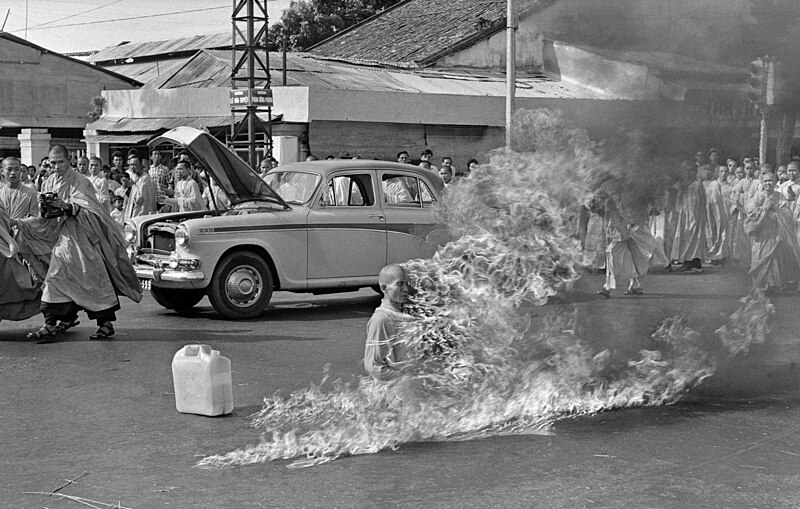Some photographs capture moments so powerful and rare that they become irreplaceable pieces of history. While many of these images have been widely circulated, only a handful of original prints still exist, making them treasured artifacts that connect us to pivotal events and remarkable figures. Each of these historic photos tells a unique story—of courage, tragedy, resilience, or innovation—and offers a glimpse into the past that shaped the world we know today. This collection of rare photographs stands as a tribute to the events and people who left an indelible mark on history, with each print serving as a tangible link to moments that might otherwise fade with time.
“Earthrise” by William Anders, 1968

This iconic photograph captured by astronaut William Anders shows Earth emerging above the lunar horizon. Taken during the Apollo 8 mission, it marked humanity’s first glimpse of Earth from another celestial body. The image helped ignite environmental awareness worldwide, emphasizing the planet’s fragility in the vastness of space. Only a limited number of prints from this era remain, making it a highly coveted piece among collectors. Its original prints have distinct color quality and sharpness, setting them apart from modern reproductions. This photograph not only represents a technological achievement but also a shift in human perspective. Each remaining print is a powerful reminder of our connection to Earth.
“Migrant Mother” by Dorothea Lange, 1936

Dorothea Lange’s “Migrant Mother” encapsulates the hardship faced by migrant families during the Great Depression. The image captures Florence Owens Thompson, a mother of seven, looking worn but determined. Lange’s powerful composition portrays resilience in the face of extreme poverty, becoming one of the most recognized photographs of the era. Only a few of the original prints from the 1930s survive, which are treasured by museums and collectors alike. With each print carrying the nuances of Lange’s development technique, they offer a glimpse into the struggles of that time. It remains a stark reminder of economic inequality and social challenges. The few prints still around are artifacts of a defining period in American history.
“Lunch Atop a Skyscraper” by Charles C. Ebbets, 1932

This photograph shows construction workers casually eating lunch on a steel beam high above New York City. Shot during the construction of the Rockefeller Center, it conveys the daring spirit of the Great Depression era. Ebbets’ image became emblematic of New York’s skyline and American resilience. Although widely reproduced, original prints are scarce and prized for their clarity and composition. The photograph reflects the risks workers took during skyscraper construction, a common sight in the 1930s. The few remaining prints retain the original detail that modern reproductions can’t capture. Each one of these prints preserves a piece of New York’s bold history.
“Raising the Flag on Iwo Jima” by Joe Rosenthal, 1945

This iconic image by Joe Rosenthal captures six Marines raising the American flag atop Mount Suribachi during World War II. The photograph quickly became a symbol of hope and sacrifice for the Allied forces. While many reproductions exist, original prints from 1945 are rare and highly sought after. Rosenthal’s photograph won a Pulitzer Prize, further cementing its legacy. It remains a profound representation of bravery and perseverance under dire conditions. The surviving prints exhibit unique details and texture that define Rosenthal’s darkroom technique. Owning an original print connects viewers to a pivotal moment in military history.
“The Hindenburg Disaster” by Sam Shere, 1937

This shocking photograph by Sam Shere captures the exact moment the Hindenburg airship exploded. Taken at Lakehurst Naval Air Station, the image reveals the chaos of one of aviation’s greatest disasters. Shere’s photograph quickly spread, bringing attention to the dangers of airship travel. Original prints are incredibly rare, each preserving the horror and intensity of that tragic moment. The few remaining ones are especially valued for their historical impact and sharpness. Modern reproductions rarely capture the eerie quality of Shere’s original print. These prints serve as reminders of both the bold ambitions and risks of early aviation.
“The Beatles Abbey Road” by Iain Macmillan, 1969

The iconic image of The Beatles crossing Abbey Road was taken by Iain Macmillan in a brief photo session. This photograph became synonymous with the band’s legendary status. Few original prints of the Abbey Road session remain, and they are highly sought after by fans worldwide. The photo’s simplicity and symbolism captured the spirit of an era. Macmillan’s composition and timing make each print a testament to the cultural phenomenon The Beatles represented. The few remaining prints retain Macmillan’s unique contrast and shadow work. These prints continue to be cherished symbols of 1960s rock history.
“Che Guevara’s Portrait” by Alberto Korda, 1960

Alberto Korda’s portrait of Che Guevara became an enduring symbol of revolution. The photograph, taken at a funeral, captures Guevara’s intense gaze and has since been reproduced worldwide. Original prints are incredibly rare, preserved by collectors who understand its historical weight. Korda’s portrait went beyond documentation, cementing Guevara as a global icon. The photograph’s high contrast and depth make each print unique, highlighting the intensity in Guevara’s expression. The limited prints showcase Korda’s ability to capture complex emotions. This photograph stands as a striking reminder of the ideals and challenges of the revolutionary era.
“V-J Day in Times Square” by Alfred Eisenstaedt, 1945

Alfred Eisenstaedt’s “V-J Day in Times Square” shows a sailor spontaneously kissing a nurse, celebrating the end of World War II. The image encapsulated the joy and relief that flooded the U.S. after the war’s end. Original prints are now rare, with a few held by private collectors and institutions. Eisenstaedt’s composition has been widely analyzed for its spontaneity and emotion. The photograph reflects a powerful, fleeting moment in history, capturing the collective sigh of peace. Each print retains Eisenstaedt’s delicate contrast, bringing out the expressive details in the subjects’ faces. It remains a timeless symbol of wartime resilience and peacetime relief.
“The Burning Monk” by Malcolm Browne, 1963

Malcolm Browne’s image of Buddhist monk Thích Quảng Đức setting himself on fire in protest shocked the world. Captured in Saigon, the photograph brought attention to the religious persecution in South Vietnam. Original prints are extremely rare, each one a powerful reminder of human sacrifice for justice. The image had a profound impact on public opinion, influencing political decisions worldwide. Browne’s composition emphasized the gravity of the monk’s act, conveying both sorrow and respect. Each print holds the emotional weight of the event, preserved for posterity. It continues to stand as a symbol of peaceful protest taken to the extreme.
“A Harvest of Death” by Timothy H. O’Sullivan, 1863

Taken after the Battle of Gettysburg, Timothy H. O’Sullivan’s photograph captures the bleak aftermath of the Civil War’s deadliest battle. It shows lifeless soldiers lying in a field, hauntingly peaceful. This image brought the stark reality of war into American households. Only a few original prints remain, preserved by historians and collectors. Each print reflects O’Sullivan’s technical skill, particularly in capturing depth and shadow. The photograph became a turning point in war documentation, shaping public perception. Original prints provide a rare connection to one of America’s most defining wars.
“Dali Atomicus” by Philippe Halsman, 1948

Philippe Halsman’s surreal photograph, “Dali Atomicus,” features Salvador Dalí in mid-air alongside floating cats and splashing water. This meticulously staged shot took hours of preparation and countless retakes to achieve. Halsman’s image captures Dalí’s eccentric personality and embodies the whimsical essence of surrealism. Original prints are rare and prized for their intricate detail and vivid portrayal of suspended motion. The photograph demonstrates Halsman’s creativity, technical expertise, and collaboration with Dalí. Each print stands out with its sharp contrasts and dynamic composition, adding to its appeal. Collectors see it as a blend of fine art and photography, representing the spirit of avant-garde creativity.
“View from the Window at Le Gras” by Joseph Nicéphore Niépce, 1826

“View from the Window at Le Gras” is the oldest surviving photograph, taken by French inventor Joseph Nicéphore Niépce. Captured on a pewter plate coated in bitumen, it shows a modest view from Niépce’s window. Original prints, or copies made from the original plate, are extremely rare and preserved in museums. This photograph is more than an image; it represents the birth of photography. Niépce’s pioneering work laid the foundation for modern photographic techniques. Each surviving print carries immense historical significance, marking the beginning of visual documentation. Collectors and historians value it as an irreplaceable artifact of technological and artistic innovation.
“The Mushroom Cloud Over Hiroshima” by Charles Levy, 1945

Charles Levy’s photograph of the mushroom cloud over Hiroshima captures the devastating power of the atomic bomb. Taken from a B-29 bomber, it reveals the immediate aftermath of one of history’s most destructive events. Original prints from that period are scarce, holding profound historical weight and visual impact. The photograph serves as a reminder of the destructive potential of nuclear weapons. Each print embodies the gravity of that moment, evoking reflection on humanity’s technological advancements and ethical dilemmas. The clarity and detail in Levy’s composition make it a powerful piece of visual history. These few prints continue to be reminders of the event’s far-reaching consequences.
“Ruby Shooting Oswald” by Robert H. Jackson, 1963

Robert H. Jackson’s photograph of Jack Ruby shooting Lee Harvey Oswald is one of the most dramatic images in American history. Captured moments after President John F. Kennedy’s assassin was killed, the photograph reveals the chaos and unpredictability of the era. Original prints are highly rare, each preserving Jackson’s fast reflexes and sharp focus. This image became a staple of the Kennedy assassination narrative, highlighting the intensity surrounding the event. Jackson’s shot captures Oswald’s expression and the tension in the scene with exceptional clarity. The few existing prints embody the shock and turmoil of the 1960s. They continue to intrigue and provoke discussions about one of America’s most contentious eras.
This article originally appeared on Rarest.org.
More From Rarest.Org
“Saturday Night Live” has seen some of the most iconic stars take center stage as hosts, and age has never been a barrier to delivering an unforgettable performance. From legendary actors to comedic powerhouses, the show has featured a range of talents, proving that age can bring a new level of wisdom, humor, and experience to the screen. Read more.
17 Oldest Cities in Florida

Florida is known for its beaches and sunshine, but it’s also home to some of the oldest cities in the United States, each with its own unique history and charm. From Spanish colonial settlements to historic river towns and early frontier outposts, these cities capture the story of Florida’s growth over the centuries. Read more.
Comic book covers have long played a critical role in defining the identity and value of a comic. These iconic images not only entice readers but also become cherished by collectors for their artistic merit and cultural significance. Read more.


